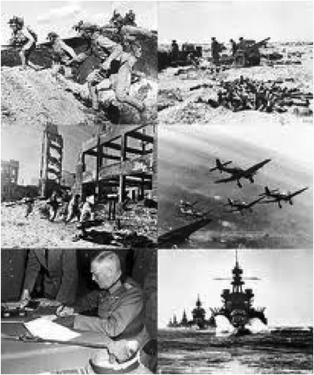
This picture shows nearly every aspect of WWII in Europe: the air warfare, the new land fighting, and even the bombing of London.
World War II[]
The Pacific War
While Germany was at war in Europe, the United States and Japan started to have confrontations of their own. It started when Japan invaded and conquered Manchuria and China. [1] Later in 1940, Japan and Germany signed the Tripartite Pact where Japan became allies with Germany and Italy in the Axis powers. [1] The United States began to be threatened by actions the Japanese were taking and feared that the Japanese were becoming too powerful. They did not want Japan to continue to have power in Manchuria and China, so they put economic sanctions on Japan. [1] The Japanese responded by attacking the United States and British troops in Asia. [1] By attacking the troops in Asia, the Japanese knew the United States was suffering from a shortage of oil, and by controlling the oil in Asia, it would hurt the U.S. in the long run. [1] After failed attempts to come to an agreement, Japan attacked the United States on their home front. On December 7, 1941, Japan attacked Pearl Harbor, Hawaii. [2] It was an attack that the United States was not prepared for as they bombed the entire U.S. Pacific fleet. In response, the U.S. announced that they are going to war with Japan, and four days after the Pearl Harbor attacks, Germany declared war on the U.S. [2] After military success between both the United States and Japan, the U.S. ended the war with Japan in the most extreme military action to this day. President Truman decided to drop an atomic bomb on the Japanese cities of Hiroshima and Nagasaki. It resulted in serious devastation for Japan, such as the immediate death of 70,000 Japanese people in Hiroshima. [3] It was the first time an atomic bomb was ever launched, and caused Japan to surrender. [1]
War In Europe
October 1938 was the start of World War II as Germany invades Poland. The Nazi political party had been in power in Germany since the election of Adolf Hitler and the Socialist Party since 1930 [3]. During WWII, Germany had taken control of France, Poland, Norway, and Finland [4]. World War II was much different in the way all of the battles were fought. In World War I, the armies would fight out of trenches and progress was slow, however during WWII the fighting was much more open and trench warfare was no longer a way to fight. Also air warfare was a new factor and allowed each side to bomb the other, which leads to the great bombing of London during WWII [4]. Yet, even though the way the battles were fought the allies and axis powers stayed the same. France, England, and later in the war the United States all fought together to put down this idea of socialism and world domination. Unlike the Pacific War, the United States did not have a physical presence in Europe until Pearl Harbor [3]. With the entrance of the U.S. in WWII England and the United States fought to free France from German control. As the American armies slowly pushed back the Germans the power of the Nazis slowly dwindled until finally in 1944 when the Russians marched on Berlin. Ultimately, the Allies would defeat the German army and end the bloodiest war on May 7, 1945 [3].
Global Significance
Many factors contributed to World War II. Much like other wars, politics played a large role in why nations went to war. Communism vs. democracy were the two political ideas at the time, and each thought that the other was the wrong way to rule. Another factor that is argued to have a factor is the economy. The world had just begun to come out of the Great Depression which hit the United States hard in the 1930s. A war economy boosted productivity and in turn created jobs as well as profits for businesses [5]. In the end, this war was not just fought to be fought, there are many factors that contributed to the escalation and later the fighting that occurred.
References
1. "Holocaust History." World War II in the Pacific. Web. 21 Apr. 2012.
2. "United States Enters World War II: Brief History." World War II History Library. Web. 21 Apr. 2012.
3. "The Atomic Bombing of Hiroshima And Nagasaki." About.com 20th Century History. Web. 21 Apr. 2012.
4. "World Events during the 1940s." Wessels Living History Farm, Inc. Web. 21 Apr. 2012. <http://www.livinghistoryfarm.org/farminginthe40s/worldevents_01.html>.
5. "Effects of World War II." Wikipedia. Wikimedia Foundation. Web. 21 Apr. 2012 <http://en.wikipedia.org/wiki/Effects_of_World_War_II>.
6. "Holocaust History." World War II: Timeline. Web. 22 Apr. 2012 <http://www.ushmm.org/wlc/en/article.php?ModuleId=10007306>.{C}{C}{C}
7. "World War II." Wikipedia. Wikimedia Foundation. Web. 21 Apr. 2012 <http://en.wikipedia.org/wiki/World_War_II>.